 Coletivo Gambiologia (Fred Paulino, Ganso and Lucas Mafra), Gambiociclo, 2010 (image Eduardo Berthier)
Coletivo Gambiologia (Fred Paulino, Ganso and Lucas Mafra), Gambiociclo, 2010 (image Eduardo Berthier)
Gambiarra is the Brazilian practice of makeshifts, the art of resorting to quirky and smart improvisation in order to repair what doesn’t work or to create what you need with what you have at your disposal. Gambiologia is the ‘science’ that studies this form of creative improvisation and celebrates it by combining it with electronic-digital techniques.
Gambiologia is also the name of a collective of artists – Fred Paulino, Lucas Mafra and Paulo Henrique ‘Ganso Pessoa’ – who mix this art of improvisation with DIY culture & technology to develop electronic artifacts.
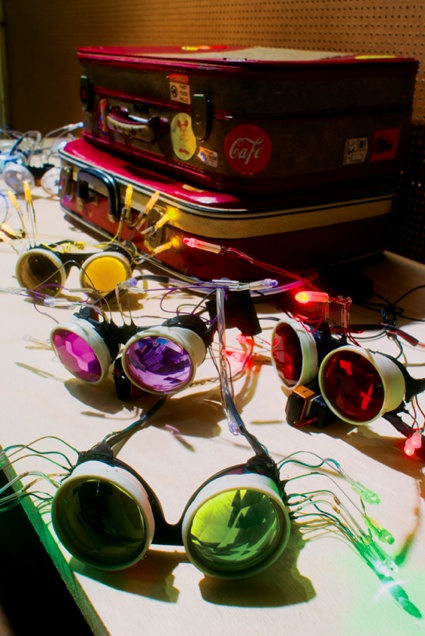 Saulo Policarpo, Prismatic Gambièrre. Image Pedro David
Saulo Policarpo, Prismatic Gambièrre. Image Pedro David
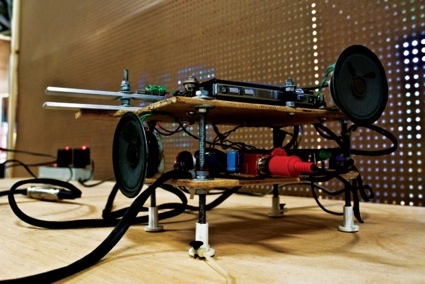 Mariana Manhães, Isso (Taça Azul) e Isso (Taça de Cristal). Image Pedro David
Mariana Manhães, Isso (Taça Azul) e Isso (Taça de Cristal). Image Pedro David
Last year, Fred Paulino gathered the work of Gambiologia along with the one of over 20 Brazilian and international artists in an exhibition titled “Gambiólogos – Kludging in a Digital Era”. The objects, sculptures and installations selected explored the concept of technological gambiarra: they adapt, reinvent recycled and found materials using electronic technologies and much improvisation.
Fred Paulino, who is an artist, designer, gambiologist as well as the curator of the exhibition, was kind enough to send me the catalog of the show a few months ago (you can also download the catalog in its PDF form.) I liked its content so much i thought it was my duty to pester him with my questions:
You translate ‘gambiologia’ with Kludging. How different is it from hacking?
Gambiologia is something like “The science of gambiarra”, which is a Brazilian cultural practice of solving problems creatively in alternative ways with low cost and lots of spontaneity, or giving unusual functions to everyday life objects. There is no exact translation for ‘gambiarra’ so we initially used kludge which means (from Wikipedia): ‘a workaround, a quick-and-dirty solution, a clumsy or inelegant, yet effective, solution to a problem, typically using parts that are cobbled together’. In the US they’d call it makeshift. Gambiologia is the study of ‘gambiarra’ in a technological context.
We actually stopped translating Gambiologia at all :^)
I ‘d say it is a specific kind of hacking – it’s the proposal of hacking not only electronics or codes, but objects as well. It’s about using things (or bits, maybe) in functions they were not initially proposed to. Modify them or join them in improvised and creative ways so they’ll not accomplish the original task anymore. Using parts that were not supposed to be together to create a distressing whole. In our case it’s also deeply linked to Brazilian folk culture.
Before we go to the artworks themselves, could you give us a few examples of everyday gambiology in the streets of Belo Horizonte?
It’s easy to find many samples of ‘gambiarras’ if you travel anywhere in Brazil. You can also get many pics if you google it but I attached some I collected myself.
Many Gambiologia’s – as we propose artistically – can be found at our group’s website www.gambiologia.net or at the collective exhibition I proposed about the theme.
Also in www.thereifixedit.com you’ll get it the north-american way.
Samples:
Audio cable fixed with candy wrapper:
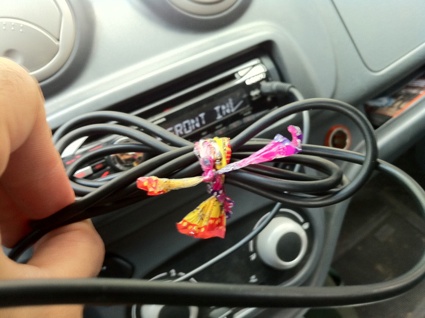
Beer chilled in suspended pail:
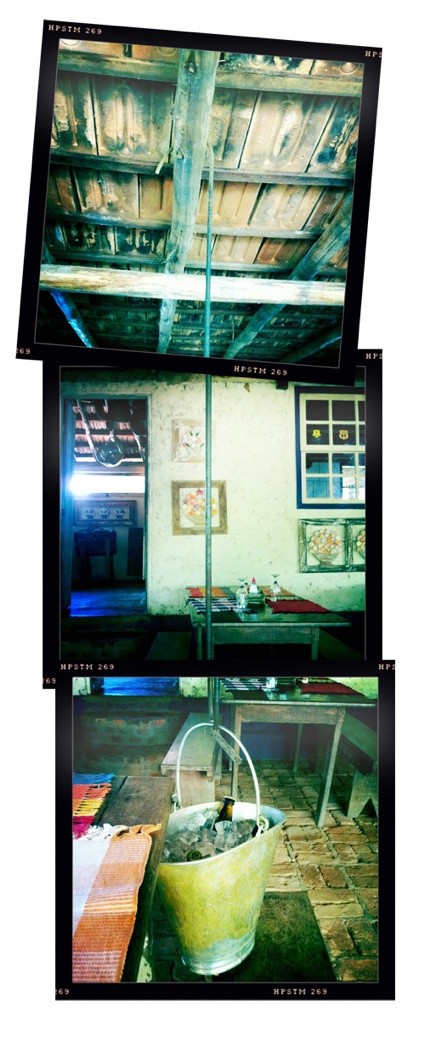
Sound systems:
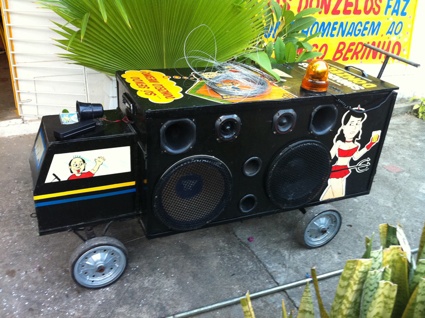
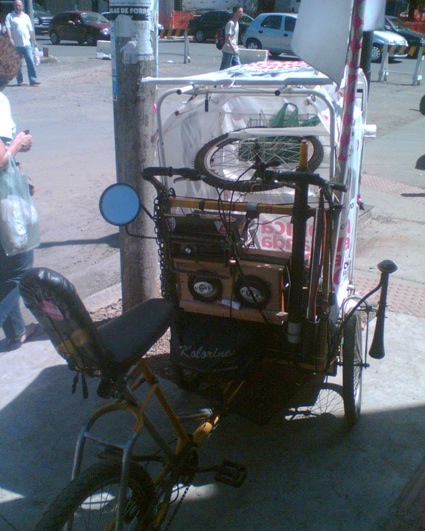
Shower in a pet bottle:

Mobile beer chilling:

Pet bottle lamp:
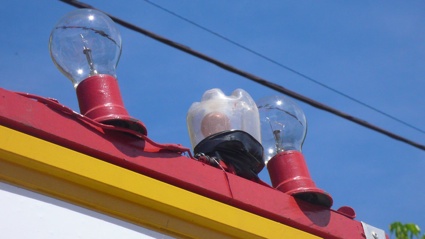
Car mirror:
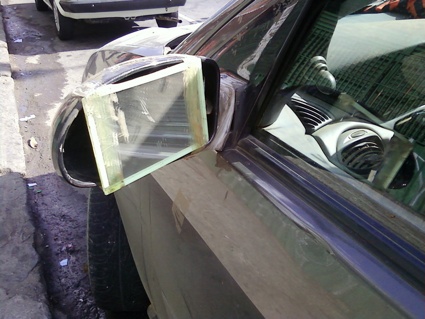
Safe plug:
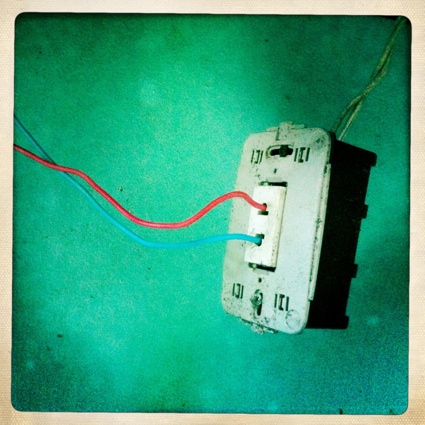
Simplest way to leave it open:
 Among the works presented in the catalogue i was particularly curious about the following ones:. O Grivo, Polvo, Eles estão vivos, Furadeiras. Can you describe them briefly and tell us what they are about?’
Among the works presented in the catalogue i was particularly curious about the following ones:. O Grivo, Polvo, Eles estão vivos, Furadeiras. Can you describe them briefly and tell us what they are about?’
Passo a Passo (Step by Step) is a work by the guys of O Grivo. They propose a random percussion symphony where different notes are played as the shadows of small pieces of wood are detected by sensors connected to a computer. Each of these pieces is attached by the end of a stick which rotates 360º at random speed, so when it gets to 0º, it plays its own note very loud. It proposes an interesting contrast between a very delicate structure and loud music tones in a kind of physically constructed musical timeline.
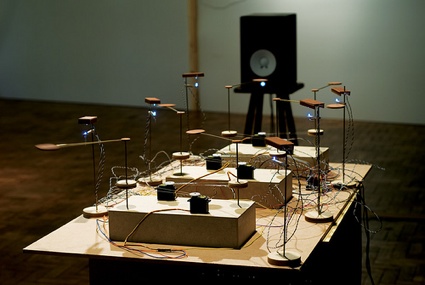 O Grivo, Passo A Passo, 2010. Image Pedro David
O Grivo, Passo A Passo, 2010. Image Pedro David
Polvo (Octopus) from Paulo Nenflidio is a sound machine made by plastic conduits. These are originally used to hold electric cables but Paulo used them to hold compressed air. As the visitor “plays” a keyboard made out of door ring bells, the conduits blow, generating different sounds. The seven bells form a complete tone set. This bizarre octopus-instrument still have an 8th note generated by an water spray on its top.
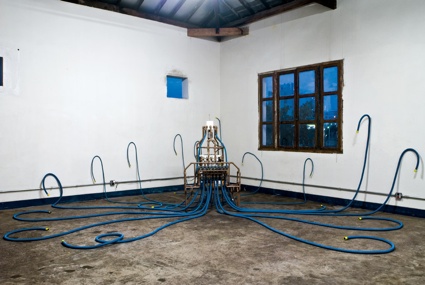 Paulo Nenflídio, Polvo, 2010. Image Pedro David
Paulo Nenflídio, Polvo, 2010. Image Pedro David
Eles Estão Vivos (They’re Still Alive) was created by Paulo Waisberg. I initially invited him to be the scenographer of the exhibition but he also came with this work. We had all these old displays and keyboards that were donated by the city’s council but we didn’t know how to use. Paulo created this artwork during the exhibition preparation just a day before the opening, using old footage of blinking eyes in the displays. In my opinion it tells a lot about how re-creating can be much more interesting than recycling. It’s also a good demonstration of how a strong sense of improvisation and spontaneity was incorporated all through the exhibition.
 Paulo Waisberg, Eles Estão Vivos. Image Pedro David
Paulo Waisberg, Eles Estão Vivos. Image Pedro David
Furadeiras (Drills) is one of the simplest exhibited artworks but surely one of the smartest. It’s by Guto Lacaz, an experienced artist from Sao Paulo. He proposed an unusual meeting between “different generation” drills – one being analogue and the other electrical. It’s an ironic interpretation between planned obsolescence and how technology evolves, sometimes just rotating around itself in an infinite loop. Or how the old (low-tech) and the new (high-tech) can live collaboratively.
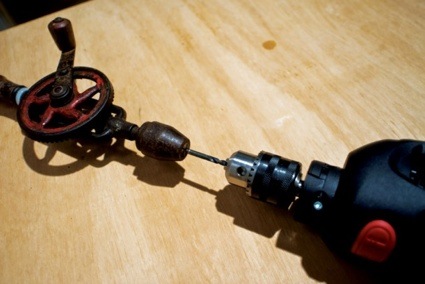 Guto Lacaz, Furadeiras. Image Pedro David
Guto Lacaz, Furadeiras. Image Pedro David
How about Gambiociclo? What made you decide to create this ‘mobile unit of multimedia transmission”?
Have you used it outside of the exhibition space? How was the experience and how did people react to it?
The Gambiocycle is inspired on Graffiti Research Lab‘s mobile broadcast unit. I got to be friend with those guys a few years ago, we made some stuff together, they proposed to me run GRL Brazilian sister cell www.graffitiresearchlab.com.br . We run it in parallel to Gambiologia.
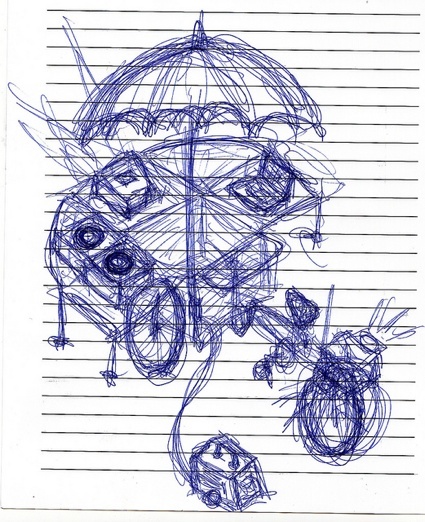 Sketch of the Gambiociclo (image by angelicasegui)
Sketch of the Gambiociclo (image by angelicasegui)
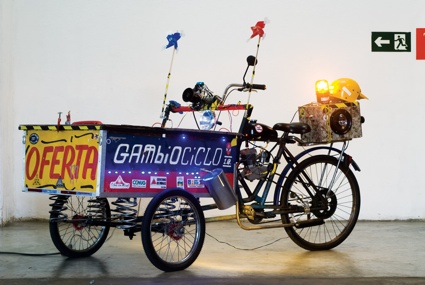 Coletivo Gambiologia (Fred Paulino, Ganso and Lucas Mafra), Gambiociclo, 2010
Coletivo Gambiologia (Fred Paulino, Ganso and Lucas Mafra), Gambiociclo, 2010
I always wish to have a multimedia vehicle that could project video and digital graffiti in public space. It’s terrific how that can be a straight path to a democratic dialogue between people and the city itself. But our MBU should be gambiological – reflecting the logics and aesthetics of ‘gambiarra’ with this strong Brazilian accent. So we built it inspired by trolleys of salesmen who ride here mostly selling products or doing political advertisement. The idea was to mix performance, happening, electronic art, graffiti and ‘gambiarras’.
Yes. People are always surprised as they’re not much used to digital graffiti or having electronic art in the streets here. But what impressed me the most is the immediate affinity that the Gambiocycle caused in ordinary people not directly involved to art. I was initially most worried about the vehicle’s funcionality or the performances’ visual contents, but probably due to the strong local aesthetics it incorporates, people were suddenly feeling more like touching the MBU, taking pictures with it or riding it. I believe it comes from this unconscious feeling of spontainity the work proposes and everybody practice some way since childhood.
And we just got the news that Gambiocycle got an Honorary Mention at Prix Ars Electronica 2011 yeah!
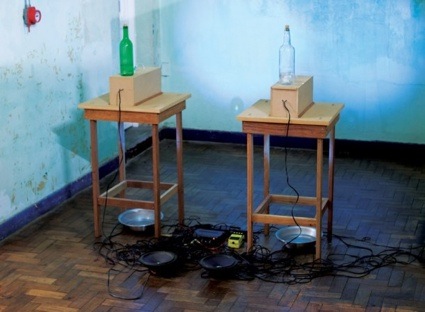 Alexandre B, O Instante Impossível. Image Pedro David
Alexandre B, O Instante Impossível. Image Pedro David
Is there a conscious art community of gambilogos in Brazil but also beyond it? Or is it more like a natural and widespread way of using technology that doesn’t really need a name or a purpose community to exist?
Gambiologia was initially the name our three guys’ collective but the word is now being used here to identify a new way of think about technology, hacking and (Brazilian) pop culture. Like a science or a movement… It somehow captured the feeling of many creators, and I believe not only in this country. Many artists worldwide are “gambiólogos” (gambiologists) without knowing that. I recently had been in touch with the work of European artists like Niklas Roy which are pretty much gambiological! That’s the feeling that Gambiólogos exhibition proposed to group and show.
It doesn’t need a name at all but if it had that should be in Brazilian Portuguese :^) Yes I strongly believe this country is a perfect example of chaotic miscegenation – cultural or technological – that results in a notion of creative spontaneity. As a colonial country we initially didn’t have enough resources for solving everyday problems so we had to invent simple and cheap solutions… Gambiologia tries to go beyond this, bring it into the art scene with an aesthetical and political discussion about technology.
Does Gambiologia have any consideration for aesthetics?
Sure! But for us we had enough of Apple-like clean aesthetics, we had enough newly-released electronics. People can’t stand so many rubbish and consumption… That’s why we love to work and play with recycling, remixing and – why not – reproposing the notion of “old” and “new”.
Obrigada Fred!
